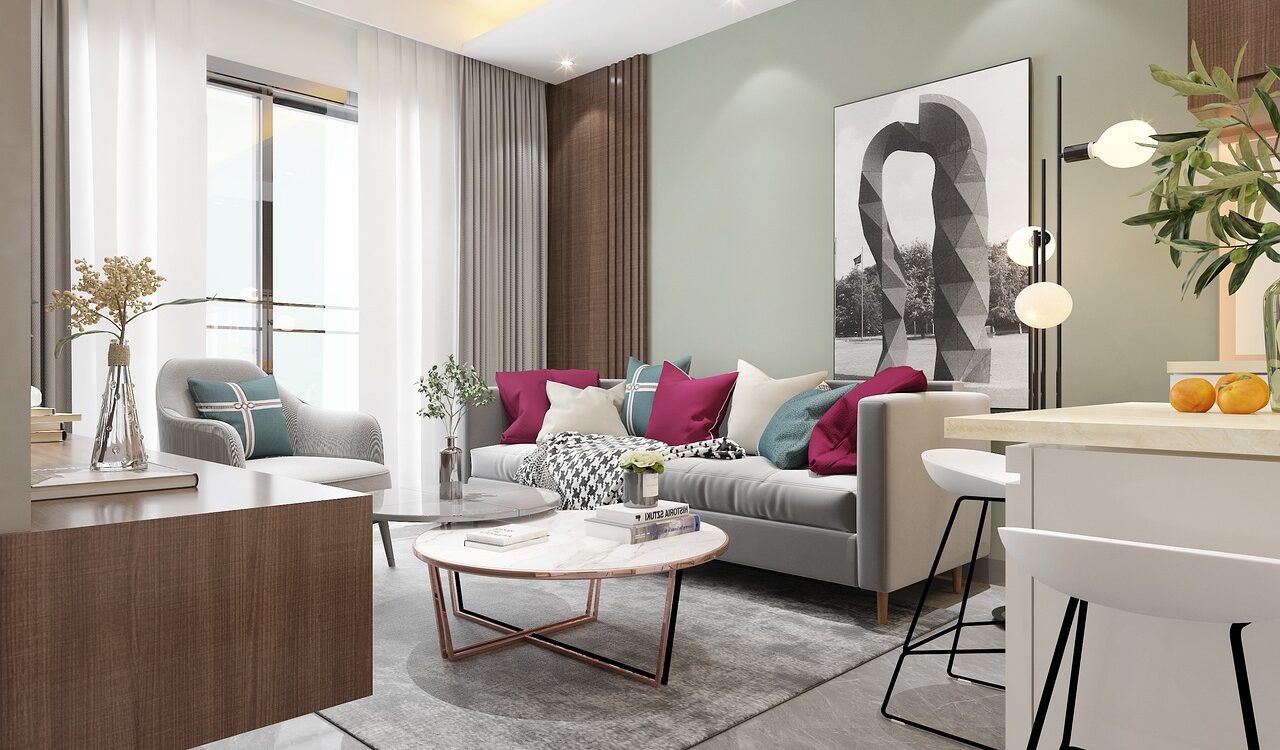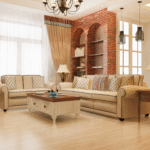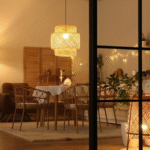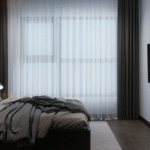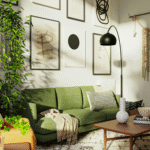Achieving the perfect harmony in interior designing is very essential for creating the best spaces that feel both inviting as well as functional. One of the very effective ways to achieve this balance is by applying the very popularly used 70/30 rule in interior designing. This principle suggests that 70% of a room should necessarily be dedicated to a dominant element, while as the remaining 30% should be used for accent elements.
Professional interior designers with a high level of expertise often rely on the various conventional design principles like the 70/30 rule to create the most visually pleasing homes.
In Kochi, where homes range from various traditional Kerala-style villas to the most modern apartments, this rule can strongly help homeowners achieve a very cohesive & aesthetically pleasing interior.
In this blog, we will explore what the 70/30 rule means, how it applies to furniture, & texture, and how more and more homeowners can use it to enhance home interior design in Kochi or anywhere else.
Explanation of the 70/30 Rule in Interior Design
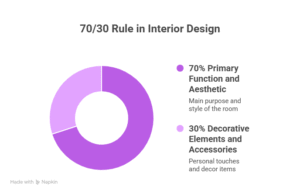
The prevalent 70/30 rule in interior designing has become a standard guideline that is being widely practised by professional interior designers in order to create a fully balanced & completely harmonious space.
It majorly involves dividing a room into two main categories, that is based on their visual weight or prominence:
- 70% – This is the dominant portion of your space. You may think of it as the main background or base, against which everything else usually plays out. It should be the most prevalent color, texture, or style in the room.
- 30% – This is the secondary or accent portion. It has all it takes to provide the desired visual interest, right contrast, depth, & personality. This is where you introduce various colors, textures, patterns, or focal points of your choice that complement, but do not overpower, the dominant 70% & also likely prevent the 70% chances of feeling monotonous within a given space.
1. The Concept of Visual Balance
Balance & proportion are the various fundamentals in design. They refer to how various elements are being arranged to create an ultimate sense of equilibrium.
The human eye naturally perceives harmony when various components or elements in a room are proportionally distributed. Any nature of imbalance can make a particular space feel “off” or make it appear uncomfortable to the occupants.
The 70/30 rule usually facilitates in achieving this just right balance by ensuring that no single element overwhelms the space under any given circumstances.
2. More Details About the 70/30 Ratio
The 70% space that represents the dominant design elements essentially includes elements like furniture, color, texture, or style.
The remaining 30% represents accent or contrast elements. For instance, a neutral room can be professionally designed with the help of bold accent colors or modern furniture with various rustic touches.
This particular contrast creates a lot of visual interest & also prevents the space from feeling monotonous.
Application of the 70/30 Rule Effectively to Various Essential Design Elements
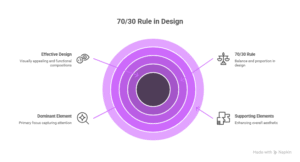
Now, let us explore in detail how the 70/30 rule applies to various aspects of home interiors.
1. Balance of Color & Palette
While choosing the perfect furniture tones, wall colors, & accent pieces, the 70/30 rule can likely guide your decisions in the best possible way.
For instance, 70% of the available space can be painted in selected neutral tones like white or beige, while 30% can feature bold accent colors like as deep mustard or teal colors.
This specifically creates optimum amount of depth & energy in the room.
3. Furniture & Layout Proportion
This ratio helps in selecting large vs. small furniture pieces for a selected interior space.
In small homes in Kochi, where space optimization is of prime significance, the 70% can be allocated to various essential furniture like a bed or sofa, while the 30% can likely be used for smaller items like side tables or chairs.
This specifically ensures that the space does not feel overcrowded.
4. Textures & Materials Being Used
Mixing rough & smooth textures or soft & hard materials as per the 70/30 rule can essentially add the desired depth to a particular room.
For instance, 70% of the room can feature absolutely smooth textures like silky curtains or a carefully selected beautiful velvet sofa, while 30% can include certain textured elements like a jute rug or some kinds of wooden decor.
This combination effectively adds a lot of visual interest without overwhelming the senses under any circumstances.
5. Design Styles & Themes
Blending two design styles, like as modern & traditional, can be easily achieved while maintaining the right level of harmony through the 70/30 rule.
For instance, 70% of the room can follow a modern minimalist style, while 30% can beautifully incorporate the most traditional Kerala elements like wooden carvings or traditional brass lamps. Striking the right balance keeps spaces cohesive, & not chaotic.
Practical Tips to Apply the 70/30 Rule at Home Effectively
The below-mentioned are a few actionable steps that you may necessarily follow to implement the 70/30 rule in your home effectively:
1. Initiate with a Dominant Theme
First of all, you should necessarily choose one primary color or theme family of your choice as your 70%.
This could either be a neutral palette like grays & whites or it can also be a bold color like navy blue. This choice sets the right tone for the room.
2. Layer Gradually with Accents
It is wise to add smaller décor elements, lighting, cushions, or wall art to complete the 30% within the space.
These accents should strongly complement the dominant theme as well as add the desired personality to the space.
3. Test with Mood Boards or Photos of Choice
You may use visual tools or apps in order to preview the right balance before committing to design changes.
Creating the best mood boards can strongly help you visualize how the 70/30 ratio works in your space.
4. Example Room Breakdown
In a Kochi apartment, a living room can likely feature neutral-colored furniture (70%) complemented by the most colorful accessories like wall art & cushions (30%).
This specifically creates a highly balanced & an absolutely inviting space.
Common Mistakes to Avoid When Using the 70/30 Rule
You should necessarily be mindful of these common errors:
1. Overusing Accents
Too many contrasting elements can likely make a space look cluttered. So, it is wise to stick to the 30% accent in order to maintain balance.
2. Ignoring Lighting
Lighting can considerably change how the 70/30 balance appears. Ensure that the lighting complements both the dominant as well as accent elements.
3. Mixing Too Many Styles
You may stick to one or two complementary styles that specifically ensures the right level of consistency.
Mixing too many styles can potentially disrupt the harmony of the space.
Expert Insights & Tips on Achieving Balance in Interior Design
Professional interior designers offer the most valuable perspectives on the 70/30 rule:
1 .Designers’ Perspective on Harmony
Designers strongly emphasize the significance of proportion & rhythm in design.
The prevalent 70/30 rule helps to achieve a comfortable visual hierarchy that likely allows the eye to rest while still being engaged by intriguing details.
2. Customizing the Rule for Unique Spaces
The ratio can tend to shift slightly (like 60/40) depending on the homeowner’s personal style or the size of a room.
Local climate & architecture – like as the coastal homes very prevalent in Kochi may influence the balance of the designs.
For instance, incorporating some natural materials like wood can strongly enhance the overall coastal aesthetic.
Conclusion
The 70/30 rule that is widely used in interior designing is undeniably a powerful tool for the professional interior designers, helping maintain the optimum balance through the right texture, proportion, as well as color.
No matter if you are refurbishing a cozy apartment in Kochi or designing your dream villa, mastering this particular rule will surely help you create the right spaces that feel all the more beautiful, balanced, & uniquely yours.
Our expert interior designer in kochi at Atlas Interiors principles like the 70/30 rule to craft homes that reflect your personality while staying effortlessly elegant. Contact us today for free consultation.
FAQs
Q1: Can the prevailing 70/30 rule be relevantly applied to all rooms in your home?
Yes, the 70/30 rule can relevantly be applied to any room possibly. You may adjust the dominant & accent elements that are based on the size as well as the purpose of a concerned room.
Q2: How do I choose the dominant color?
You may necessarily consider the mood & function of a room that you want to create. Neutral tones are indeed absolutely versatile, while the choice of bold colors can add a lot of energy in a given room.
Q3: Can I choose to use more than one accent color?
Yes, you can surely add more than one accent color without any doubt, but you must necessarily ensure the accent colors perfectly complement each other as well as the dominant color to maintain harmony.
Q4: How do I perfectly balance the sizes of furniture in a room?
You should allocate not more than 70% of the space to larger furniture pieces & utilize the remaining 30% to place smaller items in order to maintain the desired proportion.
Q5: Is the 70/30 rule a strict guideline?
No, it is a flexible guideline. You may adjust the ratio slightly based on your personal preferences & the specific characteristics of the available space.

